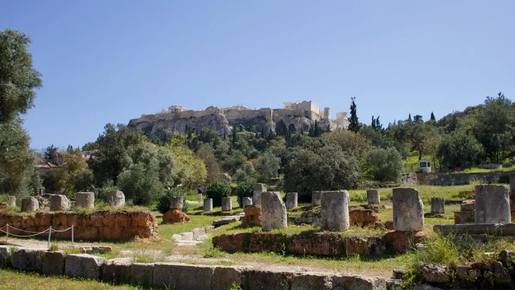Step back in time at the Ancient Agora of Athens, the birthplace of democracy. Explore the Temple of Hephaistos, the restored Stoa of Attalos, and other well-preserved ruins for a unique glimpse into ancient Athenian life.
- Visit the Temple of Hephaistos, one of the best-preserved ancient Greek temples.
- Explore the Stoa of Attalos, a restored Hellenistic building now housing the Museum of the Ancient Agora.
- Discover the birthplace of Athenian democracy, where figures like Pericles and Socrates gathered.
- Enjoy a scenic location beneath the Acropolis, blending historical insights with natural beauty.
- Ancient Agora Skip-the-Ticket-Line Ticket
Timed entry tickets are required for all visitors
We would like to inform you that from April 1st 2024, entry is only possible during the selected time slot. The ticket is valid from 15 min. before to 15 min. after the selected time slot. For example, if your time slot is 12:00, you can enter anytime between 12:00 and 13:00. We recommend arriving 30 minutes before your selected time slot to ensure a smooth entry process.
Regarding the Athens Saver Combo ticket, the mandatory selection of the date and time of visit only applies to the Acropolis & Slopes. Within 5 days you can visit the rest of the Archaeological Sites.
From 1st of April until 31 of August 08:00 - 20:00
Last entrance to the Site at 19:30
On the 1st of September the opening hours apply, due to a gradual reduction in the length of the day, as follows:
1st to 15th September 08:00 - 19:30
Last entrance to the Site at 19:00
16th to 30th September 08:00 - 19:00
Last entrance to the Site at 18:30
1st to 15th October 08:00 - 18:30
Last entrance to the Site at 18:00 and
16th to 30st October 08:00 - 18:00
Last entrance to the Site at 17:30
Location
The Ancient Agora was the heart of the Ancient city. It was crossed by the Panathenaic street which started from Dipylon at the Kerameikos and ended at the Acropolis. The plateau of the Ancient Agora is flanked from the east by the Stoa Attalos, where the Museum of the Ancient Agora operates, and from the west by the hill of Agoraios Kolonos, at the top of which dominates the Temple of Hephaistos and Athena, the best preserved temple of classical antiquity.
At the foot of the hill along the western side of the plateau, the architectural remains of the buildings that from the 5th century BC. housed the institutions of the Athenian Democracy are located.
The archaeological site to be visited is defined by the streets:
In the North by the pedestrian street Adrianou, where the central entrance of the archaeological site is located.
In the West by the archaeological pedestrian street Apostolou Pavlou, where the entrance for people with mobility impairments to the area of the Temple of Hephaestus is located
In the South by Asteroskopiou dirt road and Polygnotou street
In the East by Vrysakiou, Poikilis and Areos Streets.
Information for Disabled Persons
The Archaeological Site of the Ancient Agora is wheelchair accessible through the main entrance, at Adrianou 24 [assistance by a companion is advisable]. In the area of the Temple of Hephaistos, wheelchair access is possible through the entrance at the Thiseion Square [Apostolou Pavlou Street], upon communication [210 3214824, 3210180].
- Non-refundable







The Ancient Agora of Athens was the vibrant heart of the city, where democracy was born. Located beneath the Acropolis, it was the center of political, social, and commercial life, where citizens gathered to discuss philosophy and affairs. Key highlights include the Temple of Hephaistos, a well-preserved example of ancient Greek architecture, and the Stoa of Attalos, reconstructed in the 1950s to house the Museum of the Ancient Agora.
As the birthplace of democracy, the Agora is where figures like Pericles and Socrates debated policies that shaped Athens. The peaceful site offers stunning views of the Acropolis and connects visitors to the rich history of ancient Greece.